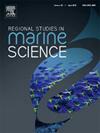A multi-scale gated attention and wavelet transform-based lightweight network for efficient plankton classification
IF 2.1
4区 环境科学与生态学
Q3 ECOLOGY
引用次数: 0
Abstract
Plankton monitoring is vital for ocean resource exploration. However, plankton images are numerous and often lack detail, making traditional classification methods prone to low accuracy and inefficiency, while ensemble learning struggles in resource-constrained environments. This study proposes a lightweight plankton image classification method based on GhostNet, named MGLR-WT-CBF-GhostNet (MWC-GhostNet), to enhance classification efficiency and reduce computational overhead. The method introduces the Multi-Scale Gated Long-Range (MGLR) module, which aggregates long-range dependencies using multi-scale asymmetric convolution kernels and learns feature weights via gating mechanisms. This fusion of multi-scale information enhances the model's ability to capture key image features. Additionally, wavelet transform is applied to depthwise convolution in the expansion layer to extract multi-frequency information, improving the model's ability to capture plankton shapes and contours. Class-Balanced Focal Loss is employed to address class imbalance and enhance recognition of hard samples. Experimental results show that MWC-GhostNet achieved an accuracy of 78.43 % and an F1 score of 0.6702 on the Kaggle121 dataset, 98.81 % accuracy and 0.9618 F1 score on the PMID2019 dataset, and 89.13 % accuracy and 0.9128 F1 score on the ZOOSCAN20 dataset. Compared to the baseline models, the proposed method improves accuracy by 1.81 %, 3.03 %, and 3.49 %, and enhances the F1 score by 5.83 %, 4.93 %, and 5.60 %, respectively. The model demonstrates high efficiency and is well-suited for deployment in resource-constrained environments.
基于多尺度门控注意力和小波变换的轻量化浮游生物分类
浮游生物监测对海洋资源勘探至关重要。然而,浮游生物图像数量众多,往往缺乏细节,使得传统的分类方法容易准确性低、效率低,而集成学习在资源有限的环境中也很困难。为了提高分类效率,减少计算开销,本研究提出了一种基于GhostNet的浮游生物图像轻量化分类方法MGLR-WT-CBF-GhostNet (MWC-GhostNet)。该方法引入了多尺度门控远程(MGLR)模块,该模块使用多尺度非对称卷积核聚合远程依赖,并通过门控机制学习特征权重。这种多尺度信息的融合增强了模型捕捉关键图像特征的能力。此外,在扩展层中应用小波变换进行深度卷积提取多频信息,提高了模型捕获浮游生物形状和轮廓的能力。采用类平衡焦失来解决类不平衡问题,提高硬样本的识别能力。实验结果表明,MWC-GhostNet在Kaggle121数据集上的准确率为78.43 %,F1分数为0.6702;在PMID2019数据集上的准确率为98.81 %,F1分数为0.9618;在ZOOSCAN20数据集上的准确率为89.13 %,F1分数为0.9128。与基线模型相比,该方法的准确率分别提高了1.81 %、3.03 %和3.49 %,F1分数分别提高了5.83 %、4.93 %和5.60 %。该模型具有较高的效率,非常适合在资源受限的环境中部署。
本文章由计算机程序翻译,如有差异,请以英文原文为准。
求助全文
约1分钟内获得全文
求助全文
来源期刊

Regional Studies in Marine Science
Agricultural and Biological Sciences-Ecology, Evolution, Behavior and Systematics
CiteScore
3.90
自引率
4.80%
发文量
336
审稿时长
69 days
期刊介绍:
REGIONAL STUDIES IN MARINE SCIENCE will publish scientifically sound papers on regional aspects of maritime and marine resources in estuaries, coastal zones, continental shelf, the seas and oceans.
 求助内容:
求助内容: 应助结果提醒方式:
应助结果提醒方式:


